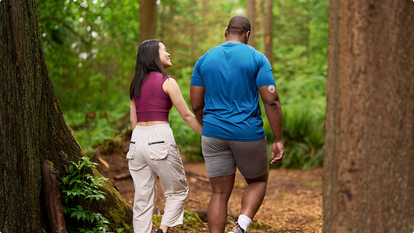Glucose basics
Staying healthy while traveling: 5 glucose-friendly tips
Published: Aug. 5, 2025
Updated: Aug. 20, 2025
4 min read

The content in this article should not be taken as medical advice. Please consult with your healthcare provider regarding your individual health needs.
Travel can be exciting, energizing, and (let’s be honest) a little chaotic. Between long days, packed schedules, and time zone shifts, it’s easy for healthy routines to get thrown off track. This can be especially true if you’re focused on managing your glucose levels. But who says traveling has to disrupt your rhythm?
With a little prep and some flexible strategies, you can enjoy your trip and feel good while doing it. Here are five tips to help you keep your glucose on track and stay healthy while traveling.

1. Pack with your glucose in mind
Travel days are unpredictable. Delays happen. Food options can be limited. That’s why it helps to have a stash of balanced snacks within reach.
A few food basics:
- Raw or roasted nuts (such as almonds, walnuts, or pistachios)
- Greek yogurt cups (unsweetened or lightly sweetened)
- String cheese or cheese sticks
- Nut butter packets (like almond or peanut butter) with apple slices or whole grain crackers
- Edamame (steamed or roasted)
- Hummus with sliced veggies (carrots, bell peppers, cucumbers)
- Turkey or chicken jerky (low sodium and low sugar preferred)
- Individual packs of roasted chickpeas or lentil snacks
- Homemade trail mix (nuts, seeds, and a small amount of unsweetened dried fruit)
- Whole grain rice cakes with nut butter
These options pair protein, healthy fats, and fiber to help you feel full and keep glucose levels more stable while you’re on the move.
2. Move when you can (even if it’s just a little)
Long travel days often mean a lot of sitting, which may cause more fluctuations in your glucose levels. Movement doesn’t have to mean a full workout. A short walk through the airport, a stretch break at a rest stop, or even a few laps around your hotel can make a real difference.
Once you’re settled, try to build activity into your trip naturally:
- Participate in a local activity such as a bike tour
- Explore somewhere new on foot
- Take the stairs when you can
In a hotel room? Try bodyweight exercises like squats, lunges, pushups, or even a quick yoga flow. Just five or ten minutes of movement can help your body use glucose more efficiently and help you feel more grounded in a new environment.

3. Don’t let every meal become a free-for-all
Food is one of travel’s greatest joys—and you absolutely deserve to savor it. By approaching each meal with intention, you can fully enjoy new flavors and experiences while supporting your glucose goals. It’s not about restriction; it’s about making choices that leave you feeling your best.
A few things to keep in mind to help you eat healthy while traveling:
- Prioritize meals with fiber or protein to slow digestion.
- Watch out for sugary drinks, especially during long meals or sightseeing.
- If you’re sampling everything, try smaller portions and share when you can.
And remember: balance out indulgent meals with ones that are lighter and more nutrient-dense. Local grilled seafood with veggies? A win. Fresh fruit from the market? Perfect. Make room for both pleasure and stability.
4. Maintain a consistent routine
Your schedule might change on the road, but keeping some basic rhythms in place can help your glucose stay more stable. Try to stick with regular meal times, aim for a consistent bedtime, and skip all-day snacking to help keep your glucose balanced.
You don’t have to follow your normal routine perfectly, but look for ways to anchor your day. That might mean having a protein-rich breakfast, going for a short walk after lunch, or using a glucose biosensor to check in on your levels throughout the day. A little consistency goes a long way.

5. Use your data to guide you
You might see some swings in your glucose levels while you travel. That’s normal. What matters most is how you respond to those patterns, not whether your glucose levels are “perfect.”
A glucose biosensor like Stelo helps you see how things like meals, movement, sleep, and stress are all working together while you’re out in the world. So, if your glucose goes up after a late dinner or long flight? That’s not a failure. That’s just information. You can use it to adjust your next move, whether that means walking after a meal, grabbing a balanced snack, or simply drinking more water.
Pro tip: Try to make it a habit to log meals, activities, and travel events in the Events tab of your Stelo app—you’ll gain valuable insights into how even small changes in your routine affect your glucose over time.

Keep progressing even when you're on the go
Travel doesn’t have to mean losing momentum. With a few simple strategies (and a little support from tools like Stelo), you can keep feeling good while exploring new places, trying new foods, and living your life.
Progress isn’t about perfection. It’s about staying connected to what works for you, no matter where the road leads.

Curated & reviewed by: Kristyn Milburn
MSN, NP-C, BC-ADM, CDCES
MSN, NP-C, BC-ADM, CDCES
Kristyn Milburn is a dedicated nurse practitioner and diabetes care and education specialist, holding board certification in advanced diabetes management.
